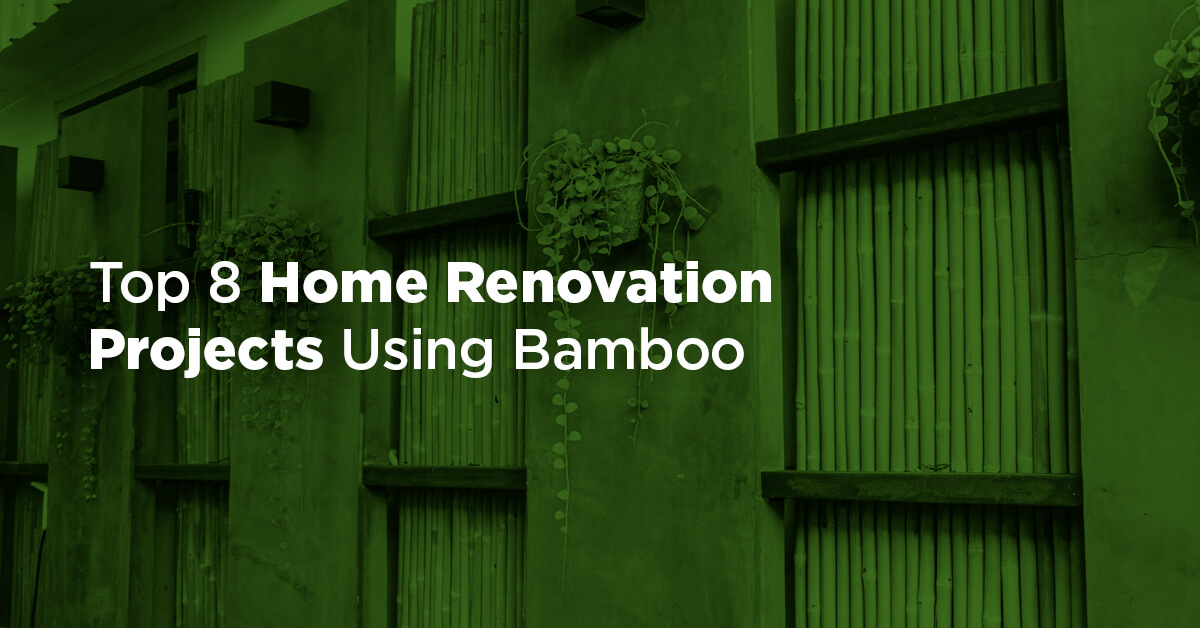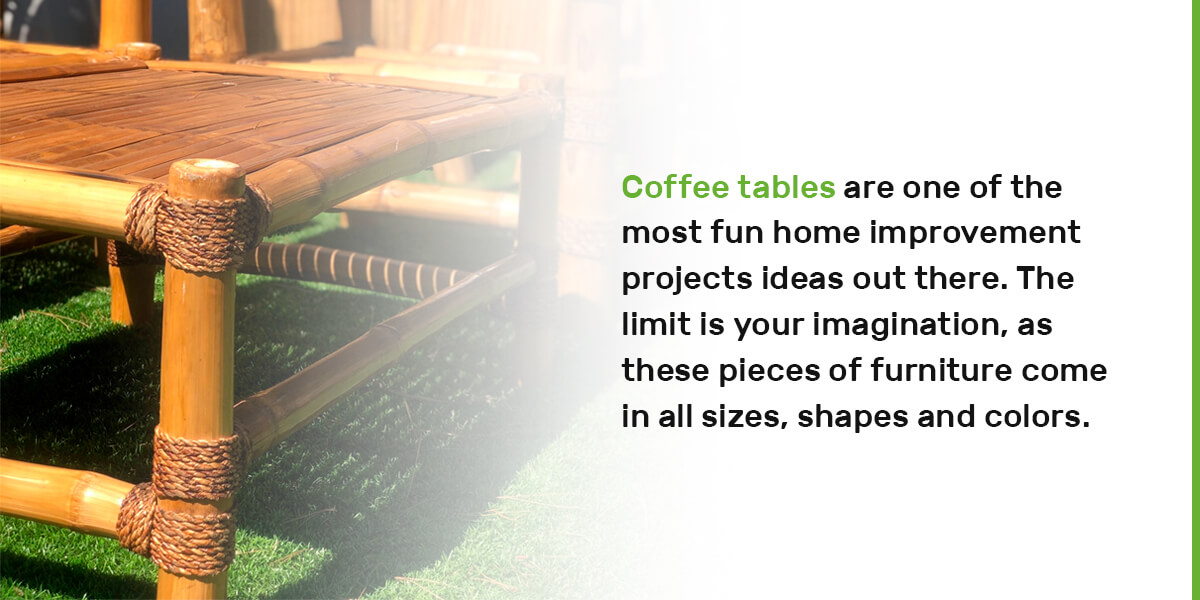
If you’re looking for an attractive, affordable and environmentally friendly way to improve the look of your home, bamboo is a great option. In this article, we’ll discuss eight interior and exterior bamboo project ideas that are fun to make and can help improve the value of your home.
Jump to Sections:
- Benefits of Making Upgrades Involving Bamboo
- Best At-Home Bamboo Projects
- How to Maintain Bamboo Products
- Buy High-Quality Bamboo Products Online at Forever Bamboo
Benefits of Making Upgrades Involving Bamboo
Bamboo products are everywhere, from flooring and countertops to cabinets and wall coverings. It’s one of the world’s most versatile building materials and offers many home improvement project ideas. The benefits of bamboo for home upgrades include:
- Strength and durability: Bamboo has a unique tissue that makes it an exceptional building material. It’s harder than both ash and oak, but also extremely flexible and light. Bamboo is an excellent choice for areas prone to earthquakes.
- Straightforward installation: Bamboo works more or less like wood and doesn’t require any special installation techniques.
- Friendliness towards the environment: When you use bamboo to renovate your home, you’ll know that it also benefits the planet. Its complex network of roots prevents erosion and also helps the soil retain water, helping with the regulation of moisture through dry and rainy seasons.
- Affordability: Renovating with bamboo could also be lighter on your wallet. Bamboo flooring options, for example, can cost half that of wood per square foot.
Best At-Home Bamboo Projects
There are a wide variety of things to build with bamboo. If you’re interested in undertaking at-home bamboo projects, here are some of the best ideas:

Room Divider
A room divider is an effective and stylish way to section off bigger rooms in your house, and they can also provide privacy for reading nooks or changing areas in bedrooms. While room dividers are available in a wide variety of materials, bamboo is one of the most attractive and atmospheric.
To make a bamboo room divider in your home, follow these steps:
- Buy bamboo poles: Begin with a number of bamboo poles cut to the height you’d like for your divider.
- Buy a base: Then, get a base that is the length you’ll need for your room. If you want to stain the bamboo a color other than its natural color, stain or paint the poles before you place each one in the base.
- Fill the base: Fill your base using quick-dry cement. You can choose between cement that is pre-mixed or products you mix yourself.
- Insert the poles: Put the poles into the cement, making sure to place each pole the same distance apart.
- Decorate: Once your cement has dried, hide the cement by covering it with flowers or river rocks.
2. Headboard
If you’d like to add a tropical decor element to the bedroom, a bamboo headboard is one of the best DIY bamboo projects. Below are a few easy steps to complete this project:
- Take measurements: Find out how many poles you’ll need to span your bed’s width. Then, add about four inches onto that measurement, as headboards tend to be a little wider than the mattress. If your bed is 60 inches wide, make the span of your bamboo headboard 64 inches.
- Lay out the poles: To create your desired design, lay your poles out in one layer and cut them to the length you want. If you’re looking for a more uniform look, ensure they’re all the same height. If you’d like a more organic look, try varying them. The height of headboards tends to be around 3 feet, and headboards are often taller in the center and lower on the edges.
- Tie the pieces together: Once you’ve laid the poles out the way you like them, take pieces of twine, string or rope measuring two feet long and ties the poles together a third of the way from the bottom and a third of the way from the top. Continue with this pattern across the rest of the poles. Then, using the twine, fix your headboard to your wall with wall hooks.
3. Wall Decor
Everyone loves unique wall decor that inspires positive feelings, and bamboo decorations are a fun way to achieve this feeling. When you decorate with bamboo, you can transform a normal wall into a focal point. Bamboo walls are a great idea to consider for your home office, too. Bringing natural elements into your office can positively affect mental health and mood.
To make some colorful and natural bamboo decor for your walls, put some poles of bamboo on tarps, newspaper or old sheets outside. Then, follow these steps:
- Apply paint: Get some paint and apply a thin coat to your bamboo poles. Let them dry overnight.
- Apply tape: Using painter’s tape or masking tape, tape designs off on each of the poles. Consider using your tape to make wider or thicker stripes of the colors you like the most.
- Add more paint: Apply more paint, and once it dries, remove the tape. Repeat this process until you are satisfied with the design you’ve created.
If you’re interested in creating a look that’s more natural, you can still make designs using natural bamboo. To add some variation in color, consider adding in poles of natural black bamboo. We recommend Phyllostachys nigra, an unusual species of bamboo with a speckly, dark brown appearance. No matter what look you settle on, you can hang these pieces of bamboo on your walls using hooks or picture wire.

4. Coffee Table
Coffee tables are one of the most fun home improvement projects ideas out there. The limit is your imagination, as these pieces of furniture come in all sizes, shapes and colors. They’re a great opportunity to add something memorable to the living room. Making your own bamboo coffee table is easier than you’d think, too — you just need some poles of bamboo, a piece of glass, twine and a drill. For the legs of your coffee table, make sure to use extra thick bamboo poles to ensure they’re strong. You can use smaller poles to make cross supports.
One benefit of building your own coffee table is being able to choose the perfect size. After figuring out the right dimensions, cut your poles to size. Leave an extra half-inch to an inch. Then, drill two holes on the table legs that are 90 degrees apart and put the cross pieces in the holes. At this point, you should have a rectangle of cross pieces attached to four legs that are vertical.
Once all the pieces are in place, use glue to secure them. You can make them even more attractive by tightly wrapping the joints with rope or twine. To preserve your bamboo and make it shine, consider lacquering your bamboo.
For the final step, all you have to do is lay on your glass top. The glass should extend roughly 3 inches past the legs of your table.
5. Coat Rack
One useful feature for an entryway or mudroom is a coat rack. While there are many prefabricated coat racks you can choose from, you can also make your own using a material that’s environmentally friend and naturally beautiful. What’s more, it’s easy to make, requiring minimal tools and under an hour of your time.
The tools you’ll need are a drill, cord or twine and four bamboo poles measuring roughly five feet in length. You can leave the bamboo natural or paint it, if you’d like. To built your bamboo coat rack, follow these steps:
- Drill holes: Start by marking a spot roughly 18 inches from one end of each pole that will serve as your coat rack’s bottom. Then, drill a tiny hole right through both poles where you made your marks, so both have an opening at the same height.
- Bundle your bamboo poles: Hold your poles of bamboo in a bundle. Roughly 18 inches down from the top, wrap your cord or twine around your bundle until it covers around 4 inches of your bundle. Tie the bundle off.
- Arrange your poles in a teepee formation: Stand up and splay out your poles so they form a teepee shape of the size you want. At this point, the only thing you have to do is run more cord through the drilled holes and tie it off, preventing the poles from spreading out too far around the bottom, collapsing the coat rack.
6. Planters
Planters are a fun way to enjoy nature, and you can use them both indoors and outdoors. To make one, begin with a bamboo pole with a fairly large diameter. Keep in mind that bamboo is hollow inside, with the exception of the nodes. To create a bamboo planter, follow these steps:
- Cut a section out: This section should have a node at one end and an internode at the other. Where you decide to cut the internode depends on the depth you want to make your planter.
- Drill a hole for drainage: Drill a tiny hole into the node located at the planter’s bottom. This hole will enable water to drain when you water your plants or when it rains.
- Drill a hole for hanging: If you just want to rest your planter on a surface, you’re already done. But if you’d like to hang your planter, you’ll need to drill additional holes on both sides of the planter, which will allow you to attach a wire. If you want to vertically hang your planter, these holes should be made close to the planter’s top. If you want to hang them diagonally, drill the holes for your wire near the planter’s bottom and one extra one close to the top. At this point, thread your wire through, making the shape of a T.
- Plant some plants: Now, plant some flowers or greenery of your choice and watch them grow and thrive.
7. Plant Trellises
If you want to grow vining or creeping plants like beans, tomatoes, peas or flowers such as morning glories and clematis, they’ll require the supporting framework of a trellis. While many people use vinyl lattices to this end, they can detract from your garden’s natural appearance. Using a trellis made from bamboo, on the other hand, will serve the same purpose and keep your garden looking naturally beautiful.
To build a trellis out of bamboo, start by determining the width and height you need for the plant you plan to grow. Then follow these steps:
- Lay out your pieces: Lay your vertical pieces straight up and down or, if you’d prefer, diagonally with the tops of the pieces angled inward. Next, evenly place your horizontal pieces over your vertical pieces, creating a grid. Also, consider the kind of plant you’re making your trellis for and the spacing that would be most appropriate.
- Tie twine around the intersections: Once you’ve arranged your grid, cut some twine pieces and tie them around all of the poles’ intersections, which will keep the trellis together.
- Place your trellis upright: Next, place your trellis upright in your yard by either planting the trellis firmly in the soil with hardwood end stakes or leaning it against your home’s exterior or other supporting structure.

8. Fencing
Fencing has many practical purposes — it can contain pets, protect children and make your home more private. However, some fencing, albeit functional, is often unattractive. If you incorporate bamboo into your fence, you can make your functional fence a beautiful sight to behold. To achieve the look you want, you can choose from many bamboo varieties and even stain the fencing.
You should affix bamboo fencing to an existing chainlink or wooden fence for support. To affix the bamboo to the framework, you can use coated deck screws, drywall screws or zip ties. Instead of assembling the bamboo fence, you can buy bamboo fencing. Bamboo fencing is sold in rolls and, when rolled out, these sections of fencing span long distances.
The bamboo poles are all attached to each other using galvanized wire. If you want to install your fencing on a wooden fence, you must predrill holes and attach your bamboo to your fence using deck screws, spacing them out. In the case of a chainlink fence, you’ll want to use zip ties around the wire. If the fence is on soil, create a barrier between the bamboo and the soil with treated two-by-four boards.
How to Maintain Bamboo Products
Although a durable material, bamboo furniture does require maintenance to look its best. If you have bamboo outdoors, it should remain a sheltered area, like under a covered patio. If there are prolonged periods of rainy weather, store your bamboo so it’s not exposed to excessive moisture.
Indoor bamboo also needs maintenance, as it may crack due to dry air. To prevent cracking, we recommend that you wipe down your bamboo product weekly to prevent cracking from overdrying. This step is especially important during the colder months when your furnace pumps dry, warm air into your house.
Routine Cleaning
Dusting your bamboo regularly, either using a dust brush vacuum attachment or a soft dusting cloth, will help the wood retain its gloss. To remove soil, we recommend using a water and mild detergent solution. When you wipe down your bamboo using detergent suds and a soft cloth, you will clean off the dirt on the surface. You may need a smaller brush with soft bristles for cleaning in crevices and between joints.
Yearly Maintenance
If enough soil accumulates on your bamboo, the methods mentioned above may not clean it sufficiently. To remove accumulated soil, you must scrub deeper using a detergent and soft-bristled scrub brush to clean fibers of the bamboo. Then, rinse out the detergent using a moist sponge, which will prevent the fibers from absorbing excessive moisture and swelling.
Drying the bamboo quickly also helps to prevent damage, so once you’re finished cleaning, you should either quickly wipe the bamboo down using a clean towel or put it outside to dry. Afterward, you can rub on a coat of liquid wax to bring back the bamboo’s luster and shine.
Removing Stains
If your bamboo stays cleaned and waxed, it is unlikely that a stain will deeply penetrate into your bamboo. If you do notice a light stain, take a soft-bristled brush and clean it quickly using sudsy water. For deeper stains, you can lightly sand them off using fine-grit sandpaper then apply wax afterward. Sanding is also a good way to remove sections that have frayed. Remember to sand your bamboo only if completely dry, as sanding wet bamboo could damage the fibers.
Buy High-Quality Bamboo Products Online at Forever Bamboo
Bamboo is a fun, attractive building material that’s also friendly to the environment. When it comes to DIY project ideas with bamboo, the sky is the limit. Forever Bamboo specializes in high-quality bamboo products and environmentally-friendly building materials. Browse our wide selection of bamboo products on our site today!

